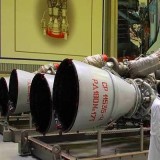Denmark could purchase up to four S 106 GlobalEye early warning aircraft in a future deal with Sweden to support coverage in the Arctic

{loadposition bannertop}
{loadposition sidebarpub}
On April 10, 2025, the Swedish government submitted a proposal in its spring 2025 budget to authorize the government to enter into a bilateral agreement with Denmark for the sale of up to four S 106 GlobalEye airborne early warning and control (AEW&C) systems and associated support equipment. The proposed transaction is intended to be conducted as a government-to-government sale in response to Denmark’s stated requirement to improve its airborne radar surveillance capabilities.Follow Army Recognition on Google News at this link
Key operational features of the GlobalEye include a radar detection range exceeding 458 kilometers from an altitude of 35,000 feet, endurance of more than 11 hours, and the ability to detect both low- and high-altitude targets. (Picture source: Saab)
Like the Gripen proposal for Peru, the Swedish government’s request includes parliamentary authorization to carry out the agreement, which would involve Sweden ordering and delivering the systems. Revenues from the sale are expected to cover all related costs incurred by the Swedish state. The proposal builds on an existing defense cooperation framework between Sweden and Denmark.
The S 106 GlobalEye is the designation used by the Swedish Air Force for the Saab GlobalEye AEW&C aircraft. The system is based on the Bombardier Global 6000/6500 long-range business jet and integrates Saab’s Erieye Extended Range (ER) radar with a range of sensors and a multi-domain command and control (C2) system. The platform is designed to conduct simultaneous surveillance operations in air, sea, and land domains. Key operational features include a radar detection range exceeding 458 kilometers from an altitude of 35,000 feet, endurance of more than 11 hours, and the ability to detect both low- and high-altitude targets. The Erieye ER radar uses an Adaptive Electronically Scanned Array (AESA) design, offering improved performance under electronic countermeasures and in cluttered environments.
GlobalEye’s sensors include the Seaspray 7500E maritime surveillance radar from Leonardo, capable of detecting small vessels and periscopes. The platform also integrates electro-optical and infrared systems, ground moving target indication (GMTI) radar, and systems for electronic support and signals intelligence. Additional onboard systems include automatic identification system (AIS), inverse synthetic aperture radar (ISAR), and identity friend or foe (IFF) and ADS-B. Data transmission is supported by voice and satellite communications and dedicated datalinks. The aircraft can operate with onboard crew at five workstations or transmit surveillance data in real time to ground stations. The platform includes a full self-protection suite with radar and laser warning receivers and countermeasures dispensers. The aircraft also has a six-seat rest area and is configured to maintain low cabin noise and pressure altitude.
The GlobalEye program was launched by Saab in February 2016 in response to market interest. Saab obtained a supplemental type certificate to modify the Global 6000 airframe and began production at its Linköping facility. Modifications include structural reinforcements, installation of sensors and electronics, aerodynamic changes, and additional power and cooling systems. The first aircraft was unveiled on February 23, 2018, and made its first flight on March 14, 2018. As of early 2018, Saab estimated a production capacity of three aircraft per year, with delivery beginning three years after contract signing. By July 2018, the first aircraft was flying frequently as part of a test campaign, and by May 2019, flight testing for certification was nearing completion.
The Erieye ER radar mounted on the GlobalEye is a ten-meter AESA system positioned atop the fuselage. Saab reports an approximate detection range of up to 550 kilometers at 35,000 feet and notes a 70 percent improvement in range compared to earlier Erieye variants. The GlobalEye also includes onboard mission systems with modular functionality. Variants have been proposed with increasing levels of capability, from standard AESA and C2 configurations to versions incorporating infrared sensors and dedicated signals intelligence suites.
The Erieye ER radar uses an Adaptive Electronically Scanned Array (AESA) design, offering improved performance under electronic countermeasures and in cluttered environments. (Picture source: Saab)
The United Arab Emirates is currently the sole operator of GlobalEye, having procured five aircraft between 2015 and 2021. Deliveries occurred in April 2020, September 2020, February 2021, April 2024, and September 2024. The total value of the five-aircraft deal is approximately 23 billion Swedish kronor (SEK). The UAE refers to its system as the Swing Role Surveillance System (SRSS). Saab has also signed a support contract with the UAE Ministry of Defence covering in-service support through 2026, valued at approximately USD 190 million.
Sweden has also ordered three GlobalEye aircraft. In June 2022, the Swedish Defence Materiel Administration (FMV) signed a contract for two units with a total value of SEK 7.3 billion, with delivery planned in 2027. In June 2024, FMV exercised the option to procure a third aircraft to replace two Saab 340 AEW&C aircraft transferred to Ukraine. The Swedish designation for the platform is S 106.
Denmark is one of several countries engaged in ongoing discussions with Sweden regarding the potential procurement of GlobalEye. In January 2025, Sweden’s Minister for Defence, Pål Jonson, confirmed that Sweden was in negotiations with Denmark and Finland for a possible joint acquisition of the system. Discussions were advanced during the January 2025 National Security Conference in Sälen. At the same event, Sweden’s opposition leader, Magdalena Andersson, called for closer Nordic cooperation in surveillance and proposed a fourth aircraft be jointly procured to support coverage from the Baltic Sea to the Arctic and Greenland. Finland, while not currently a confirmed buyer, indicated interest in seconding personnel to Sweden’s GlobalEye unit with a view to a future purchase if funding becomes available.
GlobalEye has also been offered to several other potential customers. Canada is considering the platform among alternatives, including the Boeing E-7 Wedgetail, in a potential AEW&C acquisition with a reported budget of USD 3.65 billion. In France, Saab has presented the system as a replacement for the E-3 Sentry, with cooperation frameworks established as part of a 2024 bilateral strategic innovation partnership. Greece and South Korea have been approached with proposals as well. In October 2024, Saab and Korea Aerospace Industries signed a memorandum of understanding to cooperate on the South Korean AEW&C II program, including industrial cooperation and technology transfer.
The GlobalEye is based on the Bombardier Global 6000/6500 long-range business jet and integrates Saab’s Erieye Extended Range (ER) radar with a range of sensors and a multi-domain command and control (C2) system. (Picture source: Saab)

{loadposition bannertop}
{loadposition sidebarpub}
On April 10, 2025, the Swedish government submitted a proposal in its spring 2025 budget to authorize the government to enter into a bilateral agreement with Denmark for the sale of up to four S 106 GlobalEye airborne early warning and control (AEW&C) systems and associated support equipment. The proposed transaction is intended to be conducted as a government-to-government sale in response to Denmark’s stated requirement to improve its airborne radar surveillance capabilities.
Follow Army Recognition on Google News at this link
Key operational features of the GlobalEye include a radar detection range exceeding 458 kilometers from an altitude of 35,000 feet, endurance of more than 11 hours, and the ability to detect both low- and high-altitude targets. (Picture source: Saab)
Like the Gripen proposal for Peru, the Swedish government’s request includes parliamentary authorization to carry out the agreement, which would involve Sweden ordering and delivering the systems. Revenues from the sale are expected to cover all related costs incurred by the Swedish state. The proposal builds on an existing defense cooperation framework between Sweden and Denmark.
The S 106 GlobalEye is the designation used by the Swedish Air Force for the Saab GlobalEye AEW&C aircraft. The system is based on the Bombardier Global 6000/6500 long-range business jet and integrates Saab’s Erieye Extended Range (ER) radar with a range of sensors and a multi-domain command and control (C2) system. The platform is designed to conduct simultaneous surveillance operations in air, sea, and land domains. Key operational features include a radar detection range exceeding 458 kilometers from an altitude of 35,000 feet, endurance of more than 11 hours, and the ability to detect both low- and high-altitude targets. The Erieye ER radar uses an Adaptive Electronically Scanned Array (AESA) design, offering improved performance under electronic countermeasures and in cluttered environments.
GlobalEye’s sensors include the Seaspray 7500E maritime surveillance radar from Leonardo, capable of detecting small vessels and periscopes. The platform also integrates electro-optical and infrared systems, ground moving target indication (GMTI) radar, and systems for electronic support and signals intelligence. Additional onboard systems include automatic identification system (AIS), inverse synthetic aperture radar (ISAR), and identity friend or foe (IFF) and ADS-B. Data transmission is supported by voice and satellite communications and dedicated datalinks. The aircraft can operate with onboard crew at five workstations or transmit surveillance data in real time to ground stations. The platform includes a full self-protection suite with radar and laser warning receivers and countermeasures dispensers. The aircraft also has a six-seat rest area and is configured to maintain low cabin noise and pressure altitude.
The GlobalEye program was launched by Saab in February 2016 in response to market interest. Saab obtained a supplemental type certificate to modify the Global 6000 airframe and began production at its Linköping facility. Modifications include structural reinforcements, installation of sensors and electronics, aerodynamic changes, and additional power and cooling systems. The first aircraft was unveiled on February 23, 2018, and made its first flight on March 14, 2018. As of early 2018, Saab estimated a production capacity of three aircraft per year, with delivery beginning three years after contract signing. By July 2018, the first aircraft was flying frequently as part of a test campaign, and by May 2019, flight testing for certification was nearing completion.
The Erieye ER radar mounted on the GlobalEye is a ten-meter AESA system positioned atop the fuselage. Saab reports an approximate detection range of up to 550 kilometers at 35,000 feet and notes a 70 percent improvement in range compared to earlier Erieye variants. The GlobalEye also includes onboard mission systems with modular functionality. Variants have been proposed with increasing levels of capability, from standard AESA and C2 configurations to versions incorporating infrared sensors and dedicated signals intelligence suites.

The Erieye ER radar uses an Adaptive Electronically Scanned Array (AESA) design, offering improved performance under electronic countermeasures and in cluttered environments. (Picture source: Saab)
The United Arab Emirates is currently the sole operator of GlobalEye, having procured five aircraft between 2015 and 2021. Deliveries occurred in April 2020, September 2020, February 2021, April 2024, and September 2024. The total value of the five-aircraft deal is approximately 23 billion Swedish kronor (SEK). The UAE refers to its system as the Swing Role Surveillance System (SRSS). Saab has also signed a support contract with the UAE Ministry of Defence covering in-service support through 2026, valued at approximately USD 190 million.
Sweden has also ordered three GlobalEye aircraft. In June 2022, the Swedish Defence Materiel Administration (FMV) signed a contract for two units with a total value of SEK 7.3 billion, with delivery planned in 2027. In June 2024, FMV exercised the option to procure a third aircraft to replace two Saab 340 AEW&C aircraft transferred to Ukraine. The Swedish designation for the platform is S 106.
Denmark is one of several countries engaged in ongoing discussions with Sweden regarding the potential procurement of GlobalEye. In January 2025, Sweden’s Minister for Defence, Pål Jonson, confirmed that Sweden was in negotiations with Denmark and Finland for a possible joint acquisition of the system. Discussions were advanced during the January 2025 National Security Conference in Sälen. At the same event, Sweden’s opposition leader, Magdalena Andersson, called for closer Nordic cooperation in surveillance and proposed a fourth aircraft be jointly procured to support coverage from the Baltic Sea to the Arctic and Greenland. Finland, while not currently a confirmed buyer, indicated interest in seconding personnel to Sweden’s GlobalEye unit with a view to a future purchase if funding becomes available.
GlobalEye has also been offered to several other potential customers. Canada is considering the platform among alternatives, including the Boeing E-7 Wedgetail, in a potential AEW&C acquisition with a reported budget of USD 3.65 billion. In France, Saab has presented the system as a replacement for the E-3 Sentry, with cooperation frameworks established as part of a 2024 bilateral strategic innovation partnership. Greece and South Korea have been approached with proposals as well. In October 2024, Saab and Korea Aerospace Industries signed a memorandum of understanding to cooperate on the South Korean AEW&C II program, including industrial cooperation and technology transfer.

The GlobalEye is based on the Bombardier Global 6000/6500 long-range business jet and integrates Saab’s Erieye Extended Range (ER) radar with a range of sensors and a multi-domain command and control (C2) system. (Picture source: Saab)






